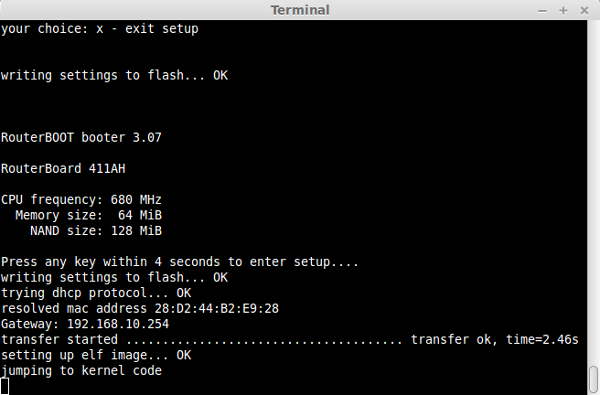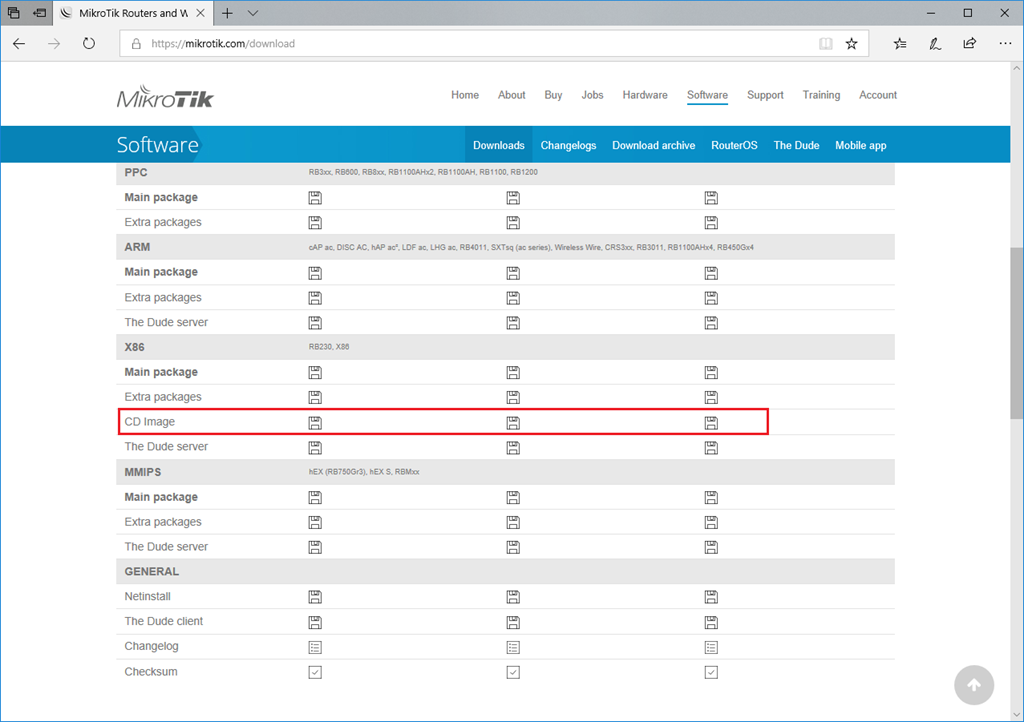Install Mikrotik From Usb Drive

Said by:on the routerboards, they use a NAND type memory, as do modern USB and CF cards. MTBF is, therefore, going to be approximately the same for all 3 types. IIRC, the expectation is around 100k write cycles.I wanted to clarify that exact same model '100K write cycle' flash device can become totally unwritable after just a few days if OS does not implement 'wear leveling' algorithm. Even with 'wear leveling'.
The implementation varies between OS/filesystems and users write different amount of data per day.Days until drive becomes 'unwritable' = (datasheet write cycles) x (file system overhead) x (total bytes in drive) / (average bytes written per day) Moral: don't go crazy writing traffic logs onto a flash drive!Butch, could you kindly check what kind of 'wear leveling' algorithm is supported in new versions of Mikrotik RouterOS? Also what is their 'file system overhead ' it will be a fraction like 0.7 for a DOS/FAT system. For USB Flash drives, Toshiba calculated that a 10,000 write cycle endurancewould enable customers to completely write and erase the entire contents onceper day for 27 years, well beyond the life of the hardware.You can see that Toshiba simply calculated (10,000 erase cycles / 365 days = 27 years ) which implies re-writing 1GB/day to a 1GB drive. This is OK for digital cameras and USB mass storage.But imagine an embedded system is updating temp files and log files many times per second effectively re-writing 1TB/day to a 1GB drive.
That will make a 10,000 cycle device un-writable after less than 10 days using the proper formula. Which BTW applies to all flash drives out there. Said by:Butch, could you kindly check what kind of 'wear leveling' algorithm is supported in new versions of Mikrotik RouterOS? Also what is their 'file system overhead ' it will be a fraction like 0.7 for a DOS/FAT system.As sibisties said, this is in the firmware for the flash card/chip. I agree with your assessment mathematically, but in practice, it doesn't seem to work that way.
That 100k write cycles may be old news, too. I am remembering from a long time ago and just went to check my main information source (google) and that number still exists. As I said, though, in practice, I have not seen an issue with write cycles. Said by:I agree with your assessment mathematically, but in practice, it doesn't seem to work that way.I agree that datasheet cycles are improving and quality device makers tend to be pessimistic, but the expected lifetime still follows that equation.We can simplify using 1.0 (zero overhead) for RouterOS filesystem. So Expected lifetime = Datasheet cycles x Flash Size / Average Writes per DayYou could prove the equation in less than a month by setting up an extreme MT configuration which echoes/logs everything imaginable to create 32GB writes per day to a 32MB CF card. Said by:I agree with your assessment mathematically, but in practice, it doesn't seem to work that way.I agree that datasheet cycles are improving and quality device makers tend to be pessimistic, but the expected lifetime still follows that equation.We can simplify using 1.0 (zero overhead) for RouterOS filesystem.
So Expected lifetime = Datasheet cycles x Flash Size / Average Writes per DayYou could prove the equation in less than a month by setting up an extreme MT configuration which echoes/logs everything imaginable to create 32GB writes per day to a 32MB CF card.Of course that's why most decent network engineers would employ a syslog server making this a moot point. Said by:Ours shows the followingRe-writes since last reboot 1,086,926Lifetime re-writes 53,355,138You are confusing writes with re-writes.write-sect-since-reboot: 1,086,926write-sect-total: 53,355,138The only way to re-write is to erase a whole block size varies from 64KB to 512KB and reprogram every bit to 1.
Within each formatted/erased block, there are many individual pages size varies from 1K to 16K which are written by flipping 1 to 0.It is not possible to flip a 0 back to 1 without erasing whole block again. So the flash controller marks the current page as garbage and copies updated content to a new (previously erased) page location.If you write a script to write the current time every second, a whole new page will be written every second.After number of seconds equal to total free pages has passed, all pages are 'garbage'. So controller will erase a whole block which had the least number of previous erasures.Each block can be erased maximum of 10,000 times in current generation (50nm) MLC flash chips used inside high capacity CF/SD/USB modules we purchase today.I talked to my semiconductor colleagues and upcoming 35nm MLC chips (even higher capacity) have even lower erase cycles in the 3000-5000 range. So life expectancy is getting worse, not better as we expect.

Said by:on the routerboards, they use a NAND type memory, as do modern USB and CF cards. MTBF is, therefore, going to be approximately the same for all 3 types. IIRC, the expectation is around 100k write cycles.I wanted to clarify that exact same model '100K write cycle' flash device can become totally unwritable after just a few days if OS does not implement 'wear leveling' algorithm. Even with 'wear leveling'.
How To Install Mikrotik On Pc
The implementation varies between OS/filesystems and users write different amount of data per day.Days until drive becomes 'unwritable' = (datasheet write cycles) x (file system overhead) x (total bytes in drive) / (average bytes written per day) Moral: don't go crazy writing traffic logs onto a flash drive!Butch, could you kindly check what kind of 'wear leveling' algorithm is supported in new versions of Mikrotik RouterOS? Also what is their 'file system overhead ' it will be a fraction like 0.7 for a DOS/FAT system. For USB Flash drives, Toshiba calculated that a 10,000 write cycle endurancewould enable customers to completely write and erase the entire contents onceper day for 27 years, well beyond the life of the hardware.You can see that Toshiba simply calculated (10,000 erase cycles / 365 days = 27 years ) which implies re-writing 1GB/day to a 1GB drive. This is OK for digital cameras and USB mass storage.But imagine an embedded system is updating temp files and log files many times per second effectively re-writing 1TB/day to a 1GB drive. That will make a 10,000 cycle device un-writable after less than 10 days using the proper formula. Which BTW applies to all flash drives out there.
Said by:Butch, could you kindly check what kind of 'wear leveling' algorithm is supported in new versions of Mikrotik RouterOS? Also what is their 'file system overhead ' it will be a fraction like 0.7 for a DOS/FAT system.As sibisties said, this is in the firmware for the flash card/chip. I agree with your assessment mathematically, but in practice, it doesn't seem to work that way. That 100k write cycles may be old news, too. I am remembering from a long time ago and just went to check my main information source (google) and that number still exists. As I said, though, in practice, I have not seen an issue with write cycles.
Said by:I agree with your assessment mathematically, but in practice, it doesn't seem to work that way.I agree that datasheet cycles are improving and quality device makers tend to be pessimistic, but the expected lifetime still follows that equation.We can simplify using 1.0 (zero overhead) for RouterOS filesystem. So Expected lifetime = Datasheet cycles x Flash Size / Average Writes per DayYou could prove the equation in less than a month by setting up an extreme MT configuration which echoes/logs everything imaginable to create 32GB writes per day to a 32MB CF card. Said by:I agree with your assessment mathematically, but in practice, it doesn't seem to work that way.I agree that datasheet cycles are improving and quality device makers tend to be pessimistic, but the expected lifetime still follows that equation.We can simplify using 1.0 (zero overhead) for RouterOS filesystem.

So Expected lifetime = Datasheet cycles x Flash Size / Average Writes per DayYou could prove the equation in less than a month by setting up an extreme MT configuration which echoes/logs everything imaginable to create 32GB writes per day to a 32MB CF card.Of course that's why most decent network engineers would employ a syslog server making this a moot point. Said by:Ours shows the followingRe-writes since last reboot 1,086,926Lifetime re-writes 53,355,138You are confusing writes with re-writes.write-sect-since-reboot: 1,086,926write-sect-total: 53,355,138The only way to re-write is to erase a whole block size varies from 64KB to 512KB and reprogram every bit to 1. Within each formatted/erased block, there are many individual pages size varies from 1K to 16K which are written by flipping 1 to 0.It is not possible to flip a 0 back to 1 without erasing whole block again. Serial sound forge 9 code activation windows 10. So the flash controller marks the current page as garbage and copies updated content to a new (previously erased) page location.If you write a script to write the current time every second, a whole new page will be written every second.After number of seconds equal to total free pages has passed, all pages are 'garbage'. So controller will erase a whole block which had the least number of previous erasures.Each block can be erased maximum of 10,000 times in current generation (50nm) MLC flash chips used inside high capacity CF/SD/USB modules we purchase today.I talked to my semiconductor colleagues and upcoming 35nm MLC chips (even higher capacity) have even lower erase cycles in the 3000-5000 range.
So life expectancy is getting worse, not better as we expect.